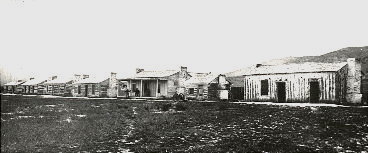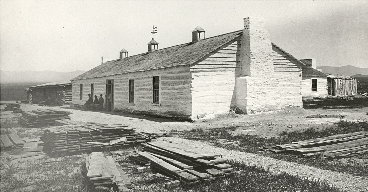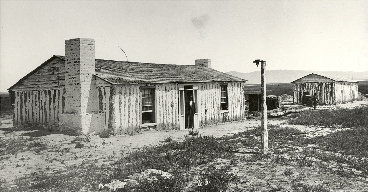|
[Index] Fort Ruby
Ruby Valley, Nevada (1862-1869) It turned out to be a sad day. At the southern end of Ruby Valley in White Pine County I stood and read the marker put up by the Lucinda Jane Saunders chapter of E. Clampus Vitus. Looking up from the plaque, I saw there was nothing of importance left of Fort Ruby. Physical memories have disappeared. Gone are the shouts of warriors in blue, clanking of weapons, the horns and drums of the small post band, and snorting horses. Gone, too, are the wives calling to each other and the pleasant sounds of children playing.
People lived and died there. Soldiers galloped out to patrol the Overland Mail Route. The first troops there wanted desperately to fight in the Civil War, so much so that they pledged to raise funds from their meager pay for expenses transferring them to the battlefront. Government officials said no. They had to stay at what was called "The Worst Post in the West." Like it or not, their job was vital. Goshute, Paiute, Shoshone, and Ute Indians wreaked havoc on the mail route. In 1863 alone the Overland company lost 150 horses, seven stations were burned, and 16 men were killed in the area. Odd that the Indians attacked the Overland Mail stations. That's where they begged for food that was freely given to them by company agents. The stations also gave employment to some of them.
Fort Ruby was about 300 miles from Salt Lake City and nearly the same distance from Carson City, far removed from what might loosely be called civilization in the old American West. Troops of the Third Regiment of California Volunteers, all 600 of them, arrived in September 1862, and spent a month constructing log structures. A month later, after preparing the fort for winter, a majority of the soldiers packed up and traveled to Salt Lake City to establish Fort Douglas. That left less than two hundred troops to patrol the Overland Mail Route. In 1864 a few months before Nevada Territory became a state, the California troopers were replaced by the Nevada Volunteers, Company B, 1st Nevada Infantry. They were a smaller outfit so patrolling the Overland Mail roads and stations was even harder but by then Indian incidents had slowed way down. Fort Ruby was on its way to outlive its usefulness.
On September 20, 1869, troops marched away up Ruby Valley. By then it was Camp Ruby. Ranch families waved goodbye as they passed. It was a sad time. The Fort and soldiers had become part of the valley. They were like family and the closing was a social and economic blow to the locals. Decades passed. Some of the buildings were sold to nearby ranchers and a couple of the log structures burned. Nature took care of what was left. Today wind blows across the site. Memories cannot stop the progress of dust devils. There are no soldiers buried in the cemetery. They were re-buried at the Presidio on the coast. Everything and everyone are gone. We can only remember Fort Ruby from printed words and two or three photographs. Sad. Source: Nevada's Northeast Frontier by Edna Patterson, Louise Ulph (Beebe), and Victor Goodwin. Photographs: Northeastern Nevada Museum, Elko, files. ©Copyright 2003 by Howard Hickson.
|


